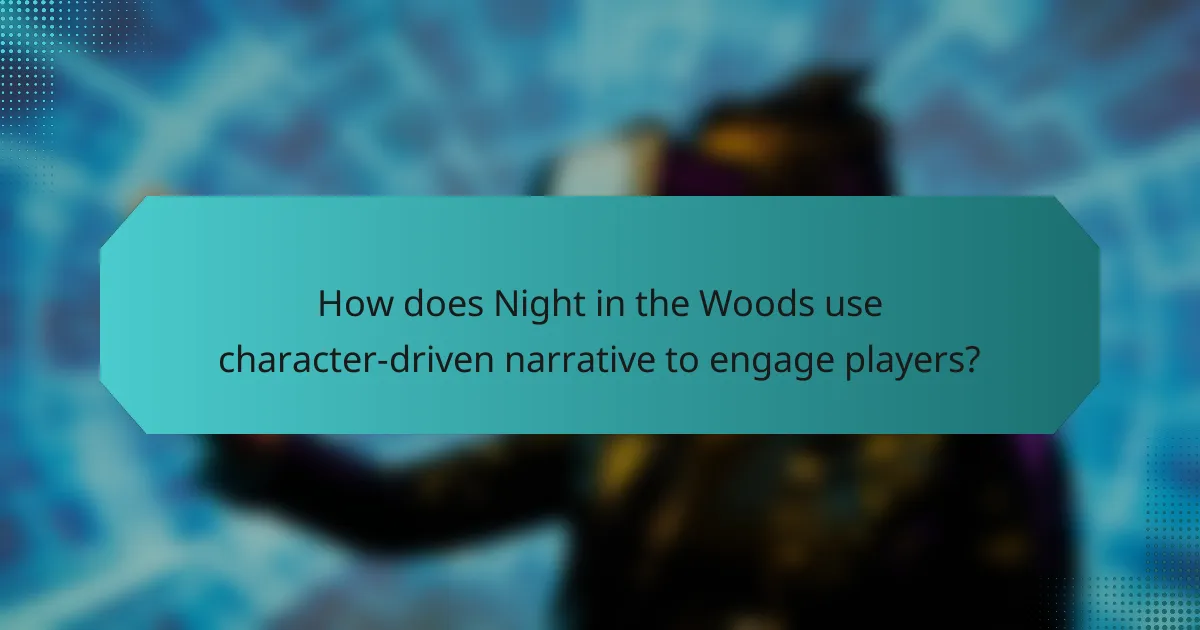Night in the Woods captivates players with its deep character-driven narrative and relevant social commentary. The game addresses themes of mental health and economic decline through relatable characters. Its unique hand-drawn art style enhances the storytelling experience, creating emotional connections. This combination fosters player engagement and reflection on real-world issues.

How does Night in the Woods use character-driven narrative to engage players?
Night in the Woods engages players through its character-driven narrative by creating relatable and complex characters. These characters reflect real-life struggles, fostering emotional connections. The game’s dialogue and interactions emphasize social commentary on issues like mental health and economic decline, enhancing player immersion. Unique attributes, such as the art style and music, complement the narrative, creating a cohesive experience that resonates with players. This combination of character depth and social relevance drives player engagement effectively.
What are the primary character arcs in Night in the Woods?
The primary character arcs in Night in the Woods focus on personal growth, identity, and the impact of societal change. Mae Borowski experiences a journey of self-discovery as she grapples with her past and mental health. Gregg and Angus navigate their relationship dynamics while confronting external pressures. Bea’s arc highlights struggles with family expectations and community disconnection. Each character’s development reflects broader themes of adulthood and economic challenges in their hometown.
How do character interactions shape the storyline?
Character interactions significantly shape the storyline in “Night in the Woods” by influencing character development and thematic depth. Each interaction reveals personal struggles, societal issues, and emotional connections, driving the narrative forward. For example, Mae’s relationships with her friends highlight themes of mental health and economic hardship. These dynamics create a rich social commentary that resonates with players, enhancing the overall experience. The unique art style complements this narrative, emphasizing emotional nuances and character expressions.
Which themes are explored through character development?
Night in the Woods explores themes of identity, mental health, and social dynamics through character development. The game delves into the struggles of its characters, reflecting broader societal issues. For example, Mae’s journey highlights the impact of mental illness, while other characters represent various facets of community and personal growth. This character-driven narrative fosters empathy and understanding, making the themes resonate deeply with players.

What social commentary is presented in Night in the Woods?
Night in the Woods presents social commentary on economic disparity, mental health, and the impact of small-town life. The game explores the struggles of its characters, reflecting broader societal issues. For instance, Mae’s return to her hometown reveals the stagnation and decline faced by many communities. The dialogue and interactions highlight themes of alienation and the search for identity amidst changing circumstances. Through its character-driven narrative, the game emphasizes the importance of connection and understanding in overcoming personal and communal challenges.
How does the game address issues of mental health?
Night in the Woods addresses mental health issues through its character-driven narrative and social commentary. The game explores themes of anxiety, depression, and existential crises faced by young adults. Characters like Mae grapple with their mental struggles, illustrating the impact of societal pressures. The narrative encourages empathy and understanding, fostering conversations around mental health. The art style complements these themes, using visuals to reflect emotional states and enhance the storytelling experience.
What economic themes are explored in the game?
Night in the Woods explores themes of economic decline, class disparity, and the struggles of small-town life. The game portrays the impact of industrial collapse on community identity and individual aspirations. Characters confront unemployment, student debt, and the fading hope for a brighter future. This social commentary reflects real-world economic challenges faced by many communities today.
How does Night in the Woods reflect contemporary social issues?
Night in the Woods reflects contemporary social issues through its exploration of economic struggles, mental health, and social alienation. The game’s characters represent diverse backgrounds, highlighting the impact of job loss and community decline on personal identities. Its narrative addresses themes like depression and the search for purpose, resonating with players facing similar challenges. The art style enhances this commentary, using vibrant visuals to contrast the darker themes, making the social critique more impactful.

What is the significance of the art style in Night in the Woods?
The art style in Night in the Woods is significant for its unique blend of hand-drawn aesthetics and vibrant colors, which enhance the emotional depth of the narrative. This visual approach complements the character-driven story and social commentary, creating an immersive experience. The distinctive character designs reflect their personalities, allowing players to connect more deeply with their struggles and relationships. The art style serves as a vehicle for themes of nostalgia and the challenges of small-town life, enriching the overall impact of the game.
How does the visual design enhance storytelling?
Visual design significantly enhances storytelling in “Night in the Woods” by creating an immersive atmosphere that reflects character emotions and themes. The art style uses vibrant colors and distinct character designs to convey personality, which deepens player connection. Additionally, the backgrounds often mirror the narrative’s tone, reinforcing social commentary on issues like economic struggle and community dynamics. This integration of visual elements with storytelling fosters a richer, more engaging experience.
What artistic influences are evident in the game’s aesthetic?
The game’s aesthetic is influenced by various artistic styles, particularly indie and graphic novel art. The character designs reflect a blend of anthropomorphism and simplicity, reminiscent of cartoon and comic illustrations. The color palette features muted tones that evoke a sense of nostalgia and emotional depth. Additionally, the backgrounds draw inspiration from rural landscapes and urban settings, enhancing the game’s themes of social commentary and community.
How does the art style contribute to the overall atmosphere?
The art style of “Night in the Woods” significantly enhances its overall atmosphere by creating a vivid, immersive world. The hand-drawn aesthetic evokes nostalgia and complements the game’s themes of small-town life and personal struggle. This unique visual approach, characterized by bold colors and expressive character designs, establishes an emotional connection with players. The art style reinforces the narrative’s depth, emphasizing social commentary through visual symbolism and environmental storytelling. As a result, the atmosphere feels rich and engaging, drawing players deeper into the characters’ experiences and the game’s underlying messages.

In what ways does Night in the Woods differ from other narrative-driven games?
Night in the Woods stands out from other narrative-driven games through its character-driven narrative, social commentary, and distinctive art style. The game emphasizes deep character development, allowing players to connect emotionally with the protagonists. It tackles themes like mental health and economic struggle, offering relevant social commentary that resonates with contemporary issues. The unique hand-drawn art style enhances its storytelling, creating an immersive experience that differentiates it from more traditional narrative games.
What unique gameplay mechanics support the narrative experience?
Unique gameplay mechanics in “Night in the Woods” enhance the narrative experience through exploration and interaction. The game allows players to engage deeply with characters, fostering emotional connections. Mechanics like dialogue choices and mini-games reflect social commentary, emphasizing themes of community and personal struggles. These elements create a rich, immersive storytelling environment that resonates with players.
How does the pacing of the story compare to similar games?
The pacing of “Night in the Woods” is slower and more contemplative compared to similar narrative-driven games. It emphasizes character development and dialogue over action, allowing players to engage deeply with themes of social commentary and personal struggles. This deliberate pacing contrasts with faster-paced games that prioritize gameplay mechanics. By focusing on exploration and interaction, “Night in the Woods” creates an immersive experience that encourages reflection on its unique attributes, such as the emotional depth of its characters and the richness of its artistic style.

What are the key takeaways for players engaging with Night in the Woods?
Players engaging with Night in the Woods should focus on its character-driven narrative, social commentary, and unique art style. The game explores themes of mental health, economic struggles, and personal relationships through relatable characters. Players should appreciate the depth of storytelling, which encourages reflection on real-world issues. The hand-drawn art style enhances the emotional impact, making each scene memorable. Engaging with the game’s dialogue choices can lead to varied experiences, emphasizing the importance of player agency in shaping the narrative.
What lessons can be learned from the characters’ journeys?
The characters’ journeys in “Night in the Woods” teach valuable lessons about growth, identity, and community. Each character’s struggles reflect real-life issues, emphasizing the importance of understanding oneself and others. Mae’s exploration of her mental health illustrates the challenges of personal change. Gregg and Angus showcase the significance of supportive relationships in navigating life’s complexities. The narrative encourages players to reflect on their own experiences and the impact of societal pressures on individual choices. Ultimately, the game highlights the necessity of connection and empathy in overcoming adversity.
How can players apply the themes of the game to real life?
Players can apply themes from “Night in the Woods” to real life by reflecting on personal relationships, societal challenges, and mental health. The game’s character-driven narrative emphasizes the importance of community and understanding. For example, players can analyze their own social interactions and the impact of economic struggles, mirroring the game’s social commentary. Additionally, the unique art style encourages creativity and self-expression, inspiring players to explore their artistic talents. Engaging with these themes promotes empathy and critical thinking in real-world situations.
What are common mistakes to avoid while playing Night in the Woods?
Avoiding common mistakes in “Night in the Woods” enhances the gameplay experience. Players often overlook character interactions, misinterpret narrative cues, neglect exploration, and rush through dialogue. Understanding each character’s unique attributes deepens engagement. Additionally, failing to appreciate the art style can diminish the emotional impact of the story. Taking time to absorb the environment and character-driven narrative enriches the overall experience.